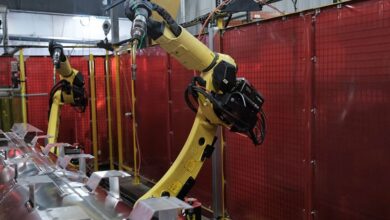Seven-Axis Robotic System for Total Hip Arthroplasty

In a recent study published in the journal Scientific Reports, researchers compared the radiologic and clinical outcomes of a novel seven-axis robotic-assisted total hip arthroplasty (THA) system called “JianJia” with those of conventional THA. They conducted a randomized, multicenter, controlled trial to evaluate the effectiveness of “JianJia”.
Background
THA is a surgical procedure that replaces a damaged hip joint with an artificial one, commonly used to treat various hip diseases and improve patients’ quality of life. However, their safety and accuracy depend on the precise positioning of the implant components, which can be challenging to achieve with conventional techniques.
Robotic-assisted THA has been developed to allow surgeons to perform the procedure with greater accuracy and consistency. These systems use preoperative computed tomography (CT) data to plan the optimal implant position and orientation, guiding surgical instruments with a robotic arm to execute the plan.
Several robotic-based THA systems are used in clinical practice. However, these systems are mostly based on six-axis robots, which have limitations in terms of technical complexity, versatility, and operative time. Additionally, the learning curve for these systems is relatively long and steep, requiring 14-35 cases to master the technique. To address these issues, the seven-axis robotic system “JianJia” has been developed as a more advanced and user-friendly robotic-assisted THA solution for surgeons.
About the Research
The authors conducted a randomized, multicenter, parallel controlled trial in three hospitals in China to evaluate the effectiveness and safety of the “JianJia” robotic-assisted THA system. This system is the first seven-axis robotic hip surgery system approved by the National Medical Products Administration of China. It consists of three parts: a trolley and mechanical arm, a central control computer, and a signal receiver.
The system uses CT data of the patient’s lower limb to create a preoperative plan and employs a seven-axis robotic arm to cut the bone and place the components accordingly. The seven-axis robotic arm offers greater flexibility and can adapt to more complex operating room environments compared to traditional six-axis robots.
The study recruited 104 patients who met the inclusion and exclusion criteria. They were randomly assigned to either the robotic-assisted THA group (RAS group) or the conventional THA group (CON group) in a 1:1 ratio. All patients underwent THA via a posterolateral approach under general anesthesia.
The primary outcome measure was the accuracy of acetabular cup placement, defined as the proportion of cups within the safe zone of inclination (30-45°) and anteversion (10-25°). Secondary outcome measures included the Harris Hip Score (HHS), deviation of anteversion and inclination, leg length discrepancy (LLD), and femoral offset. Independent investigators collected clinical and radiologic data preoperatively and postoperatively, with a follow-up period of 3 months.
Research Findings
The outcomes revealed that the RAS group achieved a significantly higher proportion of acetabular cups in the safe zone (80.85%) compared to the CON group (50.98%). Additionally, the robotic-assisted system demonstrated smaller mean absolute differences in inclination and anteversion. However, there were no significant differences between the groups in postoperative HHSs, changes in HHSs, femoral offset, or LLD.
Importantly, no complications such as infections or dislocations occurred during the follow-up period. Furthermore, logistic regression analysis indicated that the robotic-assisted approach achieved a higher safe zone ratio after adjusting for sex and body mass index (BMI).
Applications
The new seven-axis robotics-assisted THA system could improve the accuracy and consistency of implant placement, potentially reducing the risk of complications such as hip instability, implant wear, and revision surgery. It could also decrease radiation exposure and shorten the learning curve for surgeons while increasing the versatility and adaptability of the robotic arm. Moreover, it could be applied to a wide range of patients needing THA for various hip diseases, providing personalized implantation based on the patient’s anatomy and biomechanics.
Conclusion
In summary, the “JianJia ” system was a safe and effective option for THA compared to conventional THA in terms of accuracy, a shorter learning curve, and greater adaptability. It could be a valuable tool for improving component positioning and reducing the risk of instability and revision.
However, the researchers acknowledged several limitations, including the small sample size, short follow-up period, and lack of comparison with other robotic-assisted THA systems. Moving forward, they recommended further studies with larger sample sizes, longer follow-up periods, and additional outcome measures to validate the system and compare it with other systems.
Journal Reference
Tian, R., Gao, X., Kong, N. et al. A new seven-axis robotic-assisted total hip arthroplasty system improves component positioning: a prospective, randomized, multicenter study. Sci Rep 14, 12643 (2024). https://doi.org/10.1038/s41598-024-63624-5, https://www.nature.com/articles/s41598-024-63624-5



